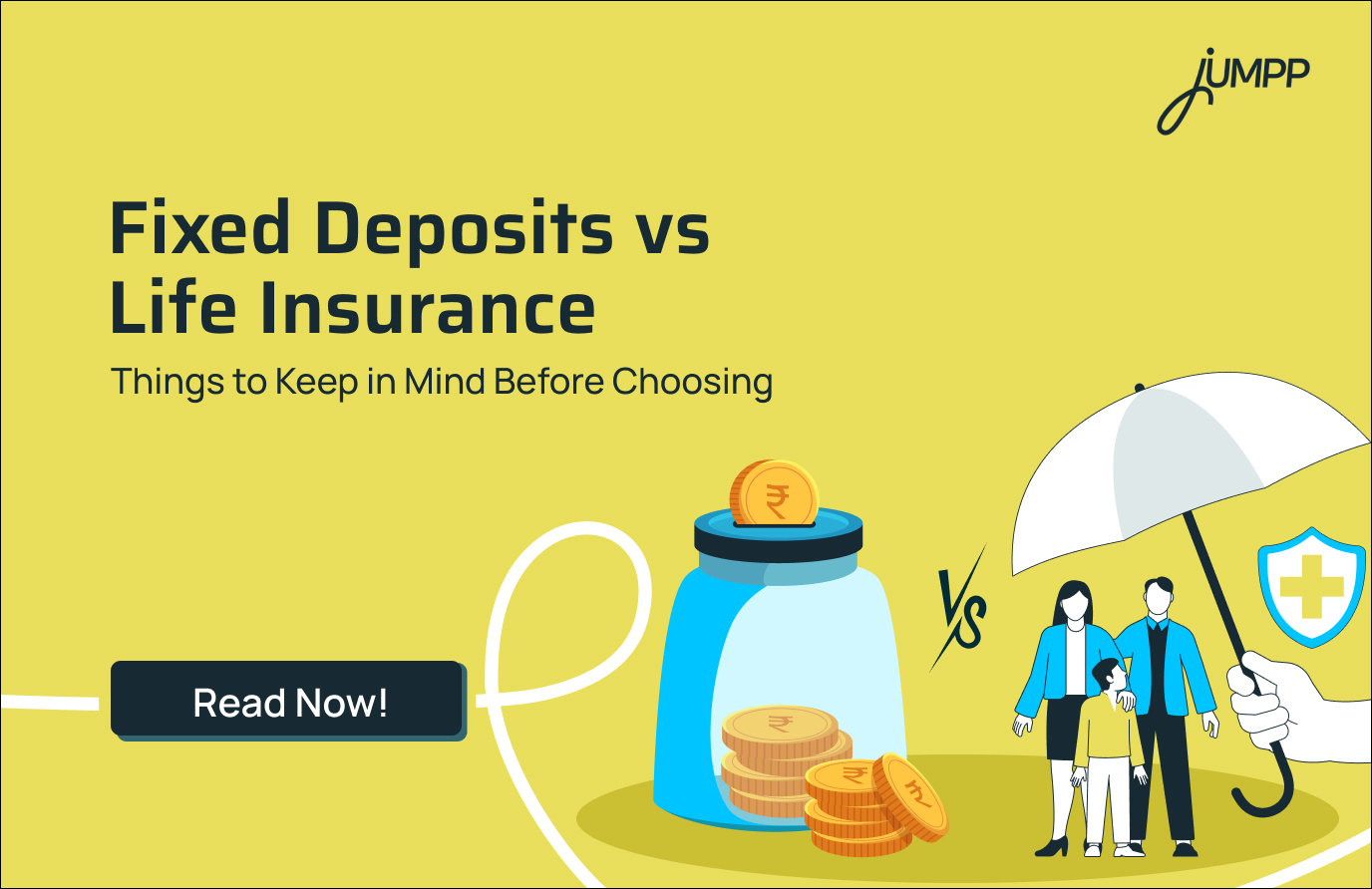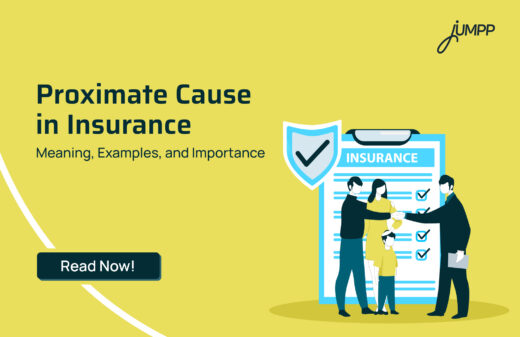FD vs Life Insurance: Types, Benefits, and Taxation

At some point in every home, usually after someone gets their first salary, a question often comes up: “Where should we put the money now?” The two most common answers echo across generations: “Fixed Deposit kar lete hain,” or “LIC le lo, safe rahega.” But have you ever actually sat down to understand the difference between FD and life insurance? What are their benefits, their purpose, and their tax implications?
FDs and life insurance are the two choices that have held the trust of Indian families for decades. The various types of FDs are a reflection of our upbringing, our fears, and the kind of financial advice that comes from grandparents and neighbours.
Now, the times have changed. Salaries are tighter. Inflation is higher. Now, the real question is not just whether you should pick FD or LIC, but whether you truly understand the difference between investment and insurance and what either of them does for you.
Let us unpack the real difference between FD and life insurance!
FD vs Life Insurance: You Must Know the Difference Between Investment and Insurance
Before comparing Fixed Deposits (FDs) and LIC policies, it is important to understand the fundamental difference between investment and insurance. These two serve entirely different purposes.
Investment is the act of putting your money into a financial instrument or asset with the expectation that it will grow over time. Instruments such as Fixed Deposits, mutual funds, stocks, or gold fall under this category.
Invest in mutual funds and stocks with a free demat account!
On the other hand, insurance is a tool for financial protection. It is designed to provide a financial safety cover in case something unexpected happens.
Difference Between Investment and Insurance
Purpose
Investment aims to grow your wealth over time. On the flipside, insurance provides financial protection against unforeseen events like death, illness, or accidents.
Return Expectation
Investment is meant to generate returns. It can be either through interest (like in FDs), dividends (in mutual funds), or capital appreciation (in stocks). Insurance, on the other hand, offers little to no returns; its primary purpose is to offer financial security to your family in case of emergencies.
Types of investments and insurance
Investment instruments include FDs, stocks, bonds, mutual funds, etc. Insurance includes Life Insurance, Term Plans, Health Insurance, and Critical Illness Cover.
Tenure Flexibility
Investments can range from short-term to long-term, depending on your financial goals. Insurance is typically a long-term commitment tied to life coverage duration.
Liquidity
Investments like FDs can be broken prematurely (often with a penalty), offering some liquidity.
However, insurance policies have lock-in periods and surrender charges, making them relatively illiquid.
So, what’s the real difference between fixed deposits and LIC policies? Here’s how they actually work.
FD vs LIC: One Builds Wealth, the Other Shields It
Let us look at the most common factors!
Taxation of FDs vs LIC in 2025
Tax on Fixed Deposits (FDs)-
The interest you earn is fully taxable.
There is no exemption on this interest under Section 80C.
However, senior citizens get relief: they can claim a deduction of up to ₹50,000 on interest income under Section 80TTB, and if they submit Form 15H.
For regular citizens, the TDS threshold is ₹50,000 per financial year, and for senior citizens, it can be higher (often ₹1 lakh or as per bank policies). If you do not provide your PAN, the TDS can be deducted at 20% instead of the usual 10%.
Tax on LIC policies-
The premiums you pay can be claimed as deductions under Section 80C up to ₹1.5 lakh per year (only in the old tax regime). Moreover, the maturity amount you receive from LIC is tax-free under Section 10(10D) if your policy meets certain conditions.
In case of ULIPs, premium of your ULIP exceeds ₹2.5 lakh per year, the maturity benefit will no longer be tax-free. Instead, it will be taxed like capital gains.
What is a Fixed Deposit?
A Fixed Deposit, or FD, is one of the oldest and most trusted savings options in India. You give a lump sum amount to the bank, lock it in for a fixed period, and earn guaranteed interest on it.
If you put ₹1,00,000 in a five-year FD at 7 percent, you will end up with around ₹1,40,000 at maturity. The money stays safe, and the growth is predictable.
But over the years, FD returns have not kept up with inflation. While they remain safe, they do not grow your money fast enough to beat the rising cost of living.
Types of Fixed Deposits You Can Open in India
There are multiple types of FDs.
1. Standard Fixed Deposit
A standard Fixed Deposit is the most basic form of FD offered by almost every bank and financial institution. You deposit a lump sum for a fixed tenure, and the bank offers a predetermined rate of interest on that amount.
2. Senior Citizen Fixed Deposit
This FD is specifically designed for individuals above the age of 60. Senior citizen FDs typically offer higher interest rates—usually 0.25% to 0.75% more than the standard rate.
3. Corporate Fixed Deposit
Corporate FDs are fixed deposits offered by non-banking financial companies (NBFCs) or corporates instead of banks. These often offer higher interest rates than bank FDs, but they also carry a higher risk.
The safety of a corporate FD depends on the credit rating of the company offering it.
4. Cumulative Fixed Deposit
In a cumulative FD, the interest is not paid out periodically. Instead, it is compounded quarterly or annually and paid along with the principal amount at the time of maturity.
5. Non-Cumulative Fixed Deposit
Here interest is paid out monthly, quarterly, or annually. This is useful for retirees or those who rely on the interest for regular expenses.
6. Flexi Fixed Deposit
Flexi FDs are a hybrid between a savings account and a fixed deposit. In this type, the extra money in your savings account—beyond a set threshold—is automatically transferred to an FD, allowing you to earn higher interest on idle funds.
This kind of deposit offers both liquidity and better returns and is ideal for individuals who want to keep their funds accessible but still want to earn more than a typical savings account.
7. Tax-Saving Fixed Deposit / Tax Saver Fixed Deposit / Tax Saving FD
A Tax-Saving FD comes with a lock-in period of five years and is eligible for a deduction of up to ₹1.5 lakh under Section 80C of the Income Tax Act. Interest earned is taxable, but the principal invested qualifies for tax benefits. Premature withdrawal and loans against this FD are not allowed.
Benefits of Fixed Deposits (FDs)
Fixed Deposits are one of the most trusted savings tools in Indian households. They are simple, secure, and offer guaranteed returns.
- Capital Protection- FDs protect your principal. You know exactly how much interest you will earn.
- Guaranteed Returns- The rate of return is fixed at the time of investment. Whether the market goes up or down, your return stays the same.
- Flexible Tenure Options- You can choose the tenure of your FD as per your needs. It could be for 7 days or for 10 years.
- Easy Liquidity- FDs can be broken if you need urgent cash, although with a small penalty.
- Tax Saving Option- Tax-saving FDs with a 5-year lock-in period are eligible for Section 80C deduction of up to ₹1.5 lakh per year.
What is LIC?
When someone says they “invested in LIC,” they usually mean a traditional life insurance plan from the Life Insurance Corporation of India. These are often endowment or money-back policies. You pay a fixed premium every year for a certain period. In return, LIC promises a maturity amount at the end of the policy term and a life cover in case of death during the term.
Now herein, you save money, and you also get insurance.
But most traditional LIC plans offer very low returns, often in the range of 4 to 5 percent annually.
Types of LIC Policies
Some policies offer pure life cover, while others combine insurance with savings or investment components.
1. Term Insurance
This is a pure life insurance product. It provides a large sum assured at a low premium. If the policyholder passes away during the policy term, the nominee receives the insured amount.
Know more about term life insurance!
2. Endowment Plans
Endowment plans offer life cover along with guaranteed maturity benefits. If the policyholder survives the term, they receive a lump sum. If not, the nominee receives the death benefit.
3. Money-Back Plans
These policies provide periodic payouts during the policy term. They are structured to give a percentage of the sum assured at regular intervals, with the balance paid at maturity or to the nominee in case of the policyholder’s death.
4. Unit Linked Insurance Plans (ULIPs)
ULIPs combine life insurance with investment in equity or debt markets. A portion of the premium goes toward life cover, and the rest is invested.
5. Pension and Annuity Plans
These are designed to provide income after retirement. During the accumulation phase, the policyholder pays regular premiums. Upon retirement, the policy starts paying out a fixed sum at regular intervals.
6. Riders
Riders are optional add-ons that enhance the coverage of your base insurance policy. They are meant to provide specific benefits in situations such as accidents, disabilities, or income loss due to death.
The most common ones are-
Accident Benefit Rider
Premium Waiver Benefit Rider
Accidental Death and Disability Benefit Rider
Critical illness Rider
Benefits of Life Insurance
Life insurance has multiple benefits to offer!
- Financial Protection for Your Family- The most important benefit of life insurance is the death benefit. If something happens to you, your nominee receives a lump sum amount.
- Encourages Long-Term Saving- Many life insurance policies, like endowment or ULIPs, come with a savings or investment component. This encourages people to save consistently over the long term.
- Tax Benefits- Under Section 80C, the premium you pay is eligible for a tax deduction of up to ₹1.5 lakh per year. Also, the amount your family receives in case of death and in some cases, maturity, is tax-free under Section 10(10D).
- Loan Against Policy- Certain life insurance policies offer the option to take a loan against the policy. This is helpful during emergencies.
- Ideal for Breadwinners and Young Parents- Life insurance is crucial for those who have financial dependents. If you are married, have children, or have ageing parents, depending on your income, having life insurance becomes a necessity.
- Customisable Add-ons- You can add riders like critical illness, accidental death, or waiver of premium, which enhance your protection without needing to buy a separate policy. These are especially helpful for people with specific health or work risks.
FD vs Life Insurance- What Are Families Actually Looking For?
In most Indian homes, financial goals are spoken about over dinner, whispered during power cuts, or discussed quietly during walks with elders. The goals sound like this:
- We should have something saved for emergencies.
- If something happens to me, my family should not suffer.
- My money should not sit idle.
- Can I get something that is safe and also useful later?
LIC vs FD- So What Should You Actually Choose?
If you are just starting out in your career, or managing a tight family budget, and want to make smart choices, here is what you can try-
Step 1: Buy a Pure Term Insurance Plan
This gives your family strong financial support in case you are not around. The premiums are low, and the cover is high.
Step 2: Use FDs for Emergency Savings
Put money in fixed deposits for short-term needs. If someone in the family falls ill, or there is a sudden school fee to be paid, FDs are easy to break. The money is safe and liquid.
Step 3: Do Not Mix Saving and Protection
Avoid traditional LIC plans unless you fully understand what you are getting into. If your goal is investment, look at mutual funds, PPF, or even index funds. If your goal is insurance, stick to a term plan. Mixing the two often leads to disappointment on both fronts.
Final Thoughts
For years, FD and LIC were the only financial tools the Indian middle class trusted. They are not bad. But they are no longer enough. Fixed Deposits give safety, but not growth. LIC traditional plans give some savings and life cover, but not much of either.
Do not pick a financial product just because someone else did. Pick it because it matches your goals, your income, and your reality.
Safety is important. But clarity is more powerful.
FD vs LIC: FAQs
Yes, you can. In fact, having both is a smart move because one helps your money grow and the other protects your family.
LIC is really worth it for people looking for long-term discipline with life coverage, but not if you are expecting high returns.
FD is really worth it for conservative investors who want fixed, guaranteed returns without market risk.
Life insurance is better for family protection. FDs, on the other hand, are better for planned short-term savings.
Both are considered safe, but LIC comes with a stronger government backing. FDs are safe too, but only up to a certain limit if the bank fails.
An option better than FD may be a hybrid mutual fund or a post office scheme if you want slightly higher returns.
The disadvantages of the LIC policy include lower returns, long lock-in periods, and less flexibility in withdrawal.






